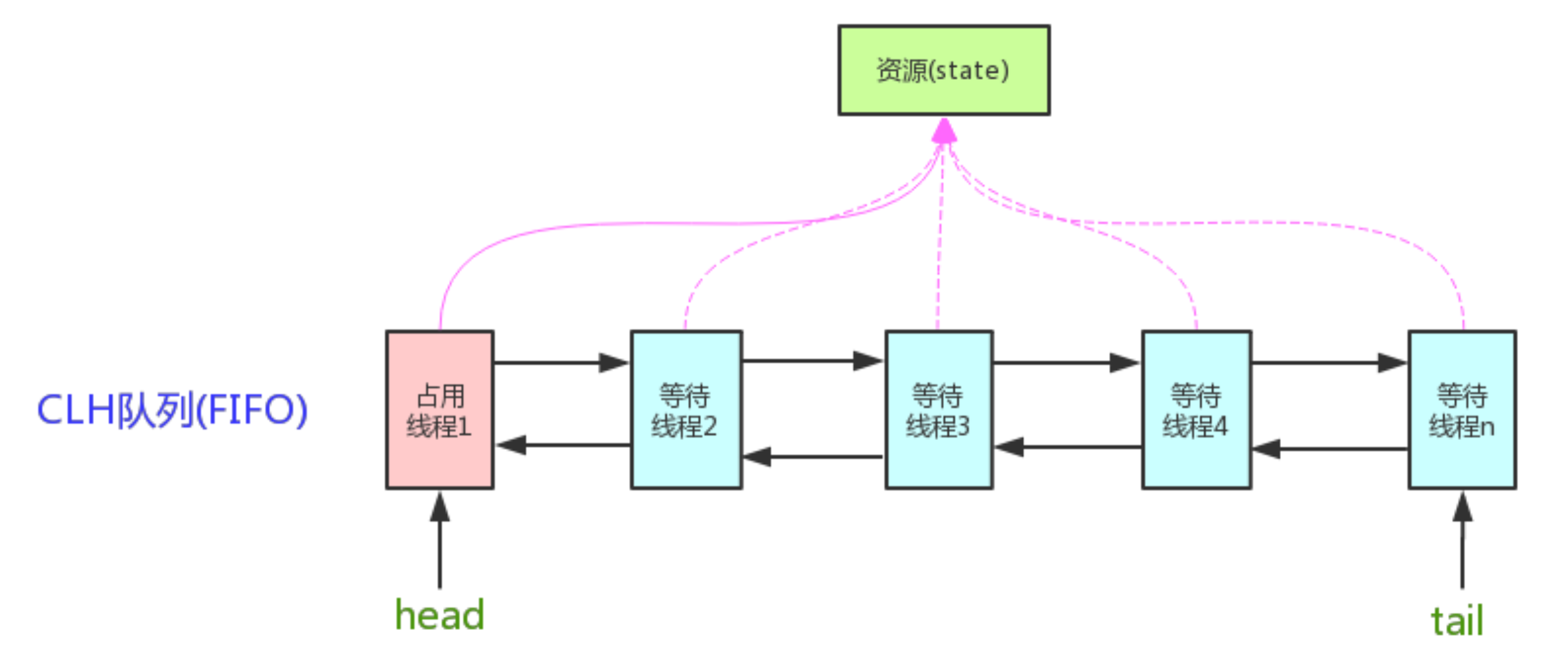AQS
AQS AbstractQueuedSynchronizer类在java.util.concurren.locks包下
AQS是一个用来构建锁和同步器的框架,使用AQS能简单且高效的构造出应用广泛的大量的同步器
例如ReentrantLock、Semaphore、ReentrantReadWriteLock、SynchronizedQueue、FutureTask等皆是基于AQS的
AQS原理分析
AQS核心思想是
如果被请求的共享资源空闲,则将当前请求资源的线程设置为有效的工作线程,并将共享资源设置为锁定状态
如果被请求的共享资源被占用,那么久需要一套线程阻塞等待以及被唤醒时锁分配的机制,这个机制AQS是用CLH队列锁实现的,即将暂时获取不到锁的线程加入队列中
CLH (Craig,Landin,and Hagersten)队列是一个虚拟的双向队列(虚拟双向队列即不出在队列实例,仅存在节点之间的关联关系)
- AQS是将每条请求共享资源的线程封装成一个CLH锁队列的一个节点来实现锁分配的

State:状态
AQS使用一个int成员变量来表示同步状态,通过内置的FIFO队列来完成获取资源线程的排队工作。AQS使用CAS对该同步状态进行原子操作实现对其值的修改
state状态的访问方式有是那种:getState()、setState()和compareAndSetState(),均是原子操作。
其中,compareAndSetState()调用了Unsafe的compareAndSwapInt()方法
AQS共享资源的方式:独占式和共享式
AQS定义了两种资源共享方式:独占式(Exclusive)和共享式(Share)
- Exclusive(独占式):只有一个线程能执行,如ReentrantLock,又分为公平锁和非公平锁
- 公平锁:按照线程在队列中的排队顺序,先到者先获得锁
- 非公平锁:当前线程要获取锁时,无视队列顺序直接抢锁,谁抢到就是谁的
- Share(共享式):多个线程可同时执行,如Semaphore和CountDownLatch
ReentrantReadWriteLock可以看成是组合式,因为ReentrantReadWriteLock也就是读写锁,允许多个线程同时对某一资源进行读操作
AQS只是一个框架,只定义了一个接口,具体资源的获取、释放都交由自定义同步器实现
不同的自定义同步器争用共享资源的方式也不同。自定义同步器在实现时只需要实现共享资源state的获取与释放方式即可,至于具体线程等待队列的维护(如获取资源失败入队、唤醒出队等),AQS已经在顶层实现好了
AQS底层使用了模板方法模式
同步器的设计基于模板方法模式,如果需要自定义同步器一般的方式是这样
- 使用者继承AbstractQueuedSynchronizer并重写指定方法,这些方法很简单,无非是对共享资源state的获取和释放
- 将AQS组合在自定义同步组件的实现中,并调用其模板方法,而这些模板方法会调用使用者重写的方法
这和我们以往通过实现接口的方式有很大的区别,这是模板方法模式很经典的一个应用
AQS使用了模板方法模式,自定义同步器时,需要重写下面几个AQS提供的模板方法:
| 方法名 | 资源共享方式 | 说明 |
|---|---|---|
| isHeldExclusively | 查询该是否正在独占资源,只有用到condition才需要去实现该方法 | |
| tryAcquire(int) | 独占方式 | 尝试获取资源:成功返回true、失败返回false |
| tryRelease(int) | 独占方式 | 尝试释放资源:成功返回true、失败返回false |
| tryAcquireShared(int) | 共享方式 | 尝试获取资源:负数表示失败;0表示成功;正数表示成功且有剩余资源 |
| tryReleaseShared(int) | 共享方式 | 尝试释放资源:如果释放资源后允许唤醒后续等待线程,则返回true,否则返回false |
默认情况下,每个方法都抛出UnsupportedOperationException。这些方法的实现必须是内部线程安全的,并且通常应该简短而不是阻塞。
AQS类中的其他方法都是final,所以无法被其他类使用,只有这几个方法可以被其他类使用
ReentrantLock
以ReentrantLock为例,state初始化为0,表示未锁定状态
A线程lock()时,会调用tryAcquire()独占该锁并state+1
此后,其他线程再tryAcquire()时就会失败,直到A线程unlock()到state=0(即释放锁)位置,其他线程才有机会获取该锁
当然,释放锁之前,A线程自己是可以重复获取此锁的(state会累加),这就是可重入的概念
但要注意,获取多少次就要释放多少次,这样才能保证state能够回到0
CountDownLatch
任务分为N个子线程去执行,state也初始化为N(注意N要与线程个数一致)。
这N个子线程时并行执行的,每个子线程执行完后countDown()一次,state会CAS减1
等到所有子线程都执行完后(state = 0 ),会unpack()主调用线程,然后主调用线程会从await()函数返回,继续后续动作
一般来说,自定义同步器要么是独占方式,要么是共享方式
以下两组方法:
tryAcquire()与tryRelease()tryAcquireShared()与tryReleaseShared()
中的一组即可
但AQS也支持自定义同步器同时实现独占和共享两种方式,如ReentrantReadWriteLock
acquire(int) 方法
acquire() 方法,获取锁,不立即返回,愿意进入队列等待,直到成功获取
// public 表明大家都来调用我// final 表明不允许重写,因为这个方法一定可以获取到锁public final void acquire(int arg) {if (!tryAcquire(arg) && // 如果 tryAcquire 可以获取锁就直接退出acquireQueued(addWaiter(Node.EXCLUSIVE), arg)) // 否则排队等待selfInterrupt();}
addWaiter(Node mode):将当前线程封装成一个 Node 然后加入等待队列,返回值为当前节点
- 如果尾结点不为空,通过 CAS 把新节点添加到 AQS 队尾
- 否则执行
enq(node)方法,触发完整入队方法加入等待队列/*** Creates and enqueues node for current thread and given mode.** @param mode Node.EXCLUSIVE for exclusive, Node.SHARED for shared* @return the new node*/private Node addWaiter(Node mode) {Node node = new Node(Thread.currentThread(), mode);// Try the fast path of enq; backup to full enq on failureNode pred = tail;if (pred != null) {node.prev = pred;if (compareAndSetTail(pred, node)) {pred.next = node;return node;}}enq(node);return node;}enq(Node) 完整入队方法/*** Inserts node into queue, initializing if necessary. See picture above.* @param node the node to insert* @return node's predecessor*/private Node enq(final Node node) {for (;;) { // 自旋Node t = tail;if (t == null) { // Must initializeif (compareAndSetHead(new Node()))tail = head;} else {node.prev = t;if (compareAndSetTail(t, node)) {t.next = node;return t;}}}}acquireQueued(final Node node, int arg)/*** Acquires in exclusive uninterruptible mode for thread already in* queue. Used by condition wait methods as well as acquire.** @param node the node* @param arg the acquire argument* @return {@code true} if interrupted while waiting*/final boolean acquireQueued(final Node node, int arg) {boolean failed = true;try {boolean interrupted = false;for (;;) {final Node p = node.predecessor();if (p == head && tryAcquire(arg)) { // 由于存在虚拟头结点,判断是不是头结点setHead(node);p.next = null; // help GCfailed = false;return interrupted;}if (shouldParkAfterFailedAcquire(p, node) && // 判断当前线程是否需要挂起parkAndCheckInterrupt())interrupted = true;}} finally {if (failed)cancelAcquire(node);}}/*** Checks and updates status for a node that failed to acquire.* Returns true if thread should block. This is the main signal* control in all acquire loops. Requires that pred == node.prev.** @param pred node's predecessor holding status* @param node the node* @return {@code true} if thread should block*/// 判断是否需要挂起当前线程private static boolean shouldParkAfterFailedAcquire(Node pred, Node node) {// 查看前置节点的 状态int ws = pred.waitStatus;if (ws == Node.SIGNAL) // 如果状态为 SIGNAL 表示前置节点也在等待获取锁/** This node has already set status asking a release* to signal it, so it can safely park.*/return true; // 则当前节点可以直接返回并挂起if (ws > 0) { // 说明状态值可能是 cancel/** Predecessor was cancelled. Skip over predecessors and* indicate retry.*/do { // 所以可以将节点从队列中删除node.prev = pred = pred.prev;} while (pred.waitStatus > 0);pred.next = node;} else { // 让前置节点的 状态为 SINGNAL 让其被唤醒/** waitStatus must be 0 or PROPAGATE. Indicate that we* need a signal, but don't park yet. Caller will need to* retry to make sure it cannot acquire before parking.*/compareAndSetWaitStatus(pred, ws, Node.SIGNAL);}return false;}如果上面的 shouldParkAfterFailedAcquire 方法返回 true,说明节点需要被挂起/*** Convenience method to park and then check if interrupted** @return {@code true} if interrupted*/private final boolean parkAndCheckInterrupt() {LockSupport.park(this); // Native 操作系统原语,线程阻塞return Thread.interrupted();}总结
- 如果当前 node 处于 headNode 的后面一个,则会自旋不断尝试获取锁,直到拿锁成功,否则进行判断自身是否需要挂起
- 判断自身是否需要被挂起:
- 如果当前线程所在的节点之前,除了 headNode 以外还有其他节点,且其他节点的 waitStatus 为 SIGNAL,那么当前节点就需要挂起,这样就能保证 headNode 之后只有一个节点在通过 CAS 获取锁,而之后的其他节点都已经挂起或者正在挂起,这样就可以尽量避免自旋带来的CPU消耗
- 在合适的实际唤醒被挂起的线程:应当是在持有锁的线程释放时
protected boolean tryRelease(int arg) {throw new UnsupportedOperationException();}/*** Releases in exclusive mode. Implemented by unblocking one or* more threads if {@link #tryRelease} returns true.* This method can be used to implement method {@link Lock#unlock}.** @param arg the release argument. This value is conveyed to* {@link #tryRelease} but is otherwise uninterpreted and* can represent anything you like.* @return the value returned from {@link #tryRelease}*/// 通过 unparkSuccessor 方法唤醒 AQS 中被挂起的节点public final boolean release(int arg) {if (tryRelease(arg)) {Node h = head;if (h != null && h.waitStatus != 0)unparkSuccessor(h);return true;}return false;}/*** Wakes up node's successor, if one exists.** @param node the node*/// 传入的是 headNode,该方法是为了唤醒 headNode 之后的 node,使其自旋获取锁private void unparkSuccessor(Node node) {/** If status is negative (i.e., possibly needing signal) try* to clear in anticipation of signalling. It is OK if this* fails or if status is changed by waiting thread.*/int ws = node.waitStatus;if (ws < 0)compareAndSetWaitStatus(node, ws, 0);/** Thread to unpark is held in successor, which is normally* just the next node. But if cancelled or apparently null,* traverse backwards from tail to find the actual* non-cancelled successor.*/// 一般是下一个节点,但如果被取消或当前为 null,从队列尾开始唤醒Node s = node.next;if (s == null || s.waitStatus > 0) {s = null;for (Node t = tail; t != null && t != node; t = t.prev)if (t.waitStatus <= 0)s = t;}if (s != null)LockSupport.unpark(s.thread); // 唤醒}